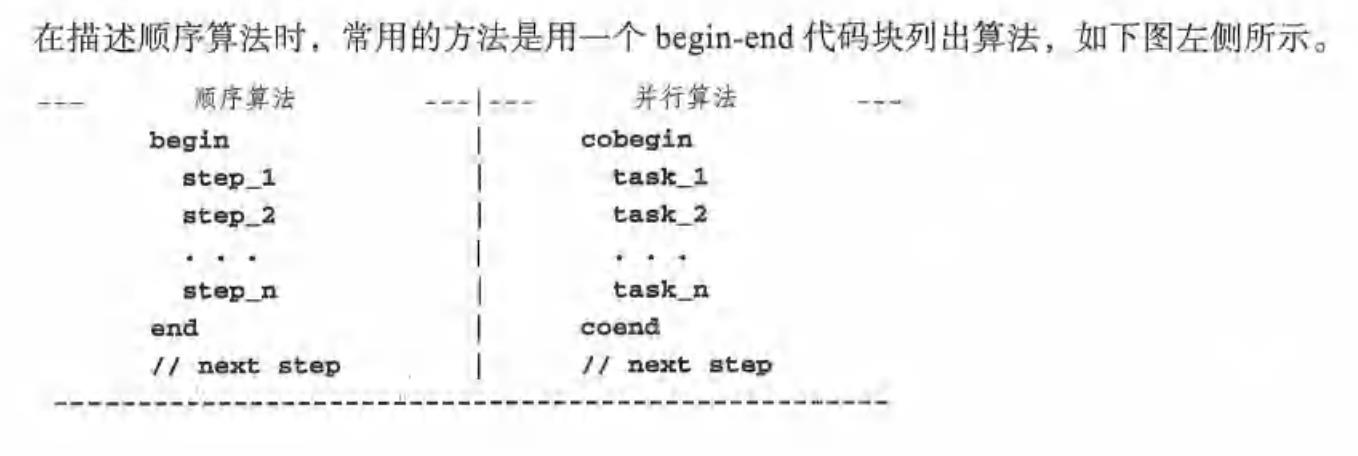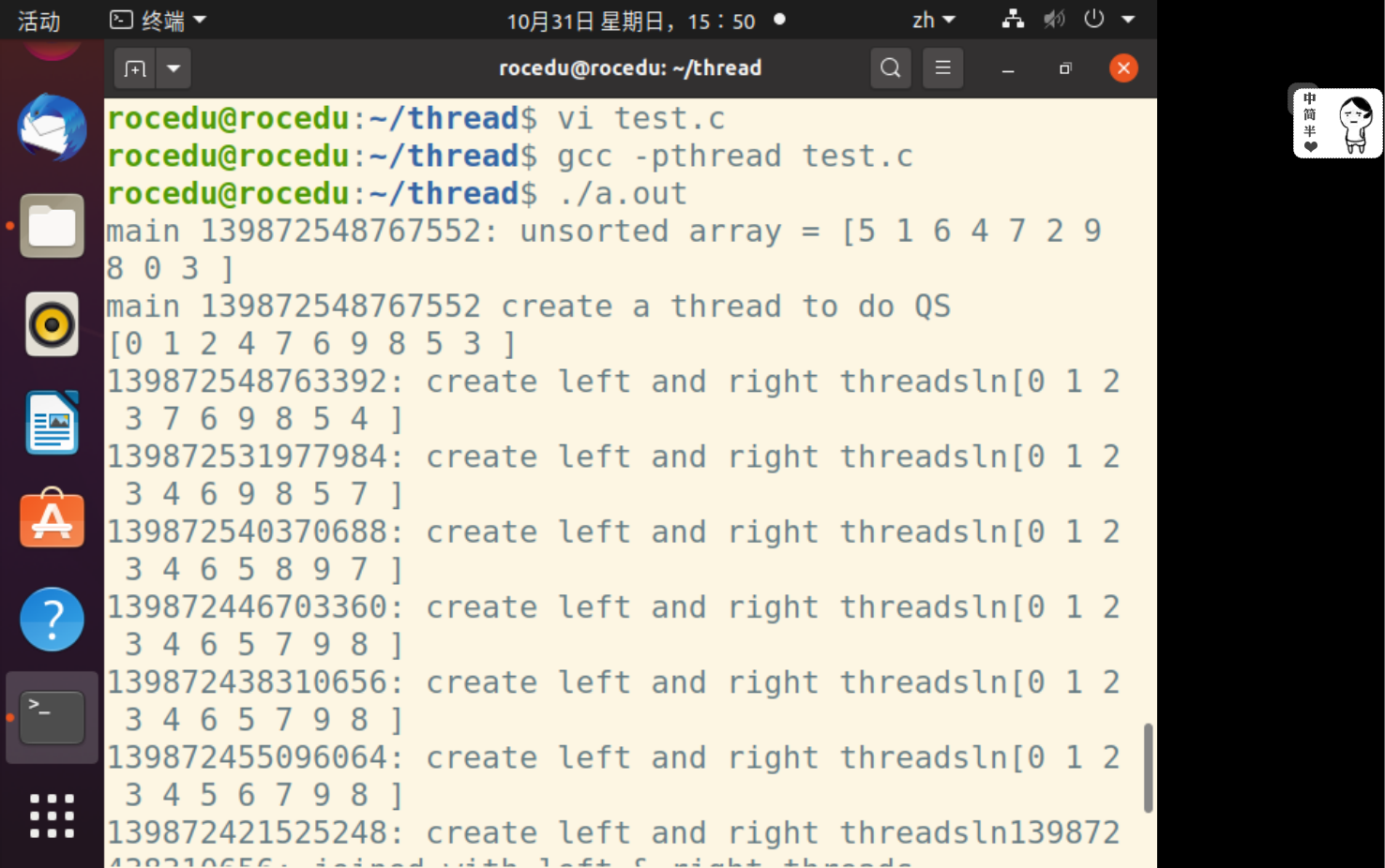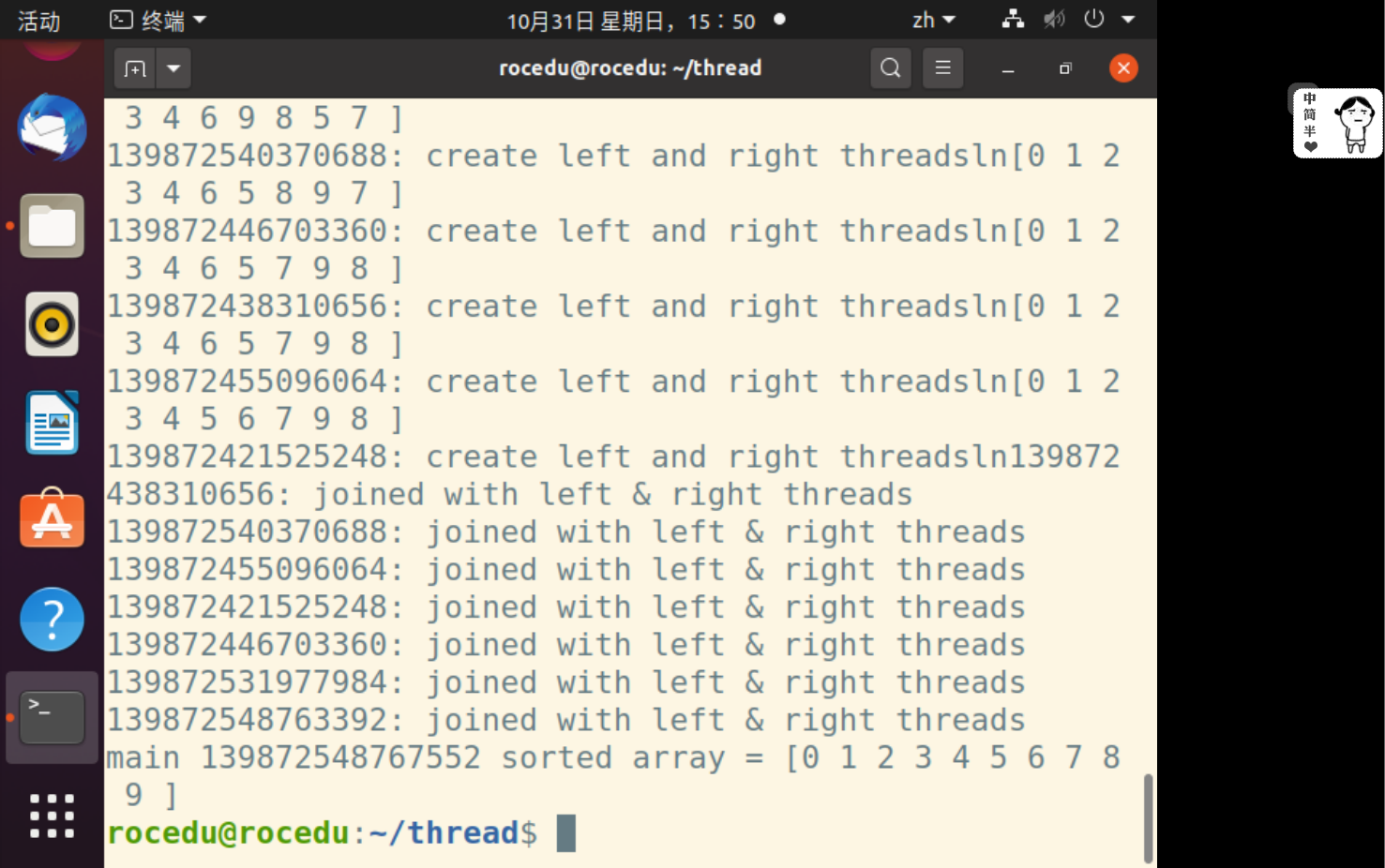第4章 并发编程
教材学习内容总结
本章论述了并发编程,介绍了并行计算的概念,指岀了并行计算的重要性;比较了顺序 算法与并行算法,以及并行性与并发性;解释了线程的原理及其相对于进程的优势;通过示 例介绍了 Pthread中的线程操作,包括线程管理函数,互斥量、连接、条件变量和屏障等线 程同步工具;通过具体示例演示了如何使用线程进行并发编程,包括矩阵计算、快速排序和 用并发线程求解线性方程组等方法;解释了死锁问题,并说明了如何防止并发程序中的死锁 问题;讨论了信号量,并论证了它们相对于条件变量的优点;还解释了支持Linux中线程的 独特方式。
1 并行
1、顺序算法和并行算法
- 顺序算法:begin-end代码块列出算法。可包含多个步骤,所有步骤通过单个任务依次执行,每次执行一个步骤,全执行完,算法结束。
- 并行算法:cobegin-coend代码块来指定独立任务,所有任务都是并行执行的,紧接着代码块的下一个步骤将只在所有这些任务完成之后执行。

2、并行性与并发性
通常,并行算法只识别可并行执行的任务,但是它没有规定如何将任务映射到处理组件。在理想情况下,并行算法中的所有任务都应该同时实时执行。然而,真正的并行执行只能在有多个处理组件的系统中实现,比如多处理器或多核系统。在单 CPU 系统中,一次只能执行一个任务。在这种情况下,不同的任务只能并发执行、即在逻辑上并行执行。在单CPU系统中,并发性是通过多任务处理来实现的。
2 线程
1、原理
- 线程是操作系统能够进行运算调度的最小单位。它被包含在进程之中,是进程中的实际运作单位。一条线程指的是进程中一个单一顺序的控制流,一个进程中可以并发多个线程,每条线程并行执行不同的任务。在Unix System V及SunOS中也被称为轻量进程(lightweight processes),但轻量进程更多指内核线程(kernel thread),而把用户线程(user thread)称为线程。
线程是独立调度和分派的基本单位。线程可以为操作系统内核调度的内核线程,如Win32线程;由用户进程自行调度的用户线程,如Linux平台的POSIX Thread;或者由内核与用户进程,如Windows 7的线程,进行混合调度。 - 同一进程中的多条线程将共享该进程中的全部系统资源,如虚拟地址空间,文件描述符和信号处理等等。但同一进程中的多个线程有各自的调用栈(call stack),自己的寄存器环境(register context),自己的线程本地存储(thread-local storage)。
一个进程可以有很多线程,每条线程并行执行不同的任务。 - 在多核或多CPU,或支持Hyper-threading的CPU上使用多线程程序设计的好处是显而易见,即提高了程序的执行吞吐率。在单CPU单核的计算机上,使用多线程技术,也可以把进程中负责I/O处理、人机交互而常被阻塞的部分与密集计算的部分分开来执行,编写专门的workhorse线程执行密集计算,从而提高了程序的执行效率。
2、优点
- 线程创建和切换速度更快。
- 线程的响应速度更快。
- 线程更适合并行计算。
3、缺点
- 由于地址空间共享,线程需要来自用户的明确同步。
- 许多库函数可能对线程不安全。
- 在单CPU系统上,使用线程解决问题实际上要比使用顺序程序慢,这是由在运行 时创建线程和切换上下文的系统开销造成的。
3 线程管理函数
1、创建线程
使用pthread_create()函数创建线程
int pthread_create(pthread_t *thread, const pthread_attr_t *attr,void *(*start_routine) (void *), void *arg);
2、线程ID
使用pthread_equal()函数对线程ID进行比较
int pthread_equal(pthread_t t1,pthread_t t2);
返回值:不同线程返回0,否则返回非0
3、线程终止
线程可以调用函数进行终止
void pthread_exit(void *status);
返回值:0退出值表示正常终止,非0值表示异常终止
4、线程连接
一个线程可以等待另一个线程的终止,通过函数终止线程的退出状态。
int pthread_join (pthread_t thread, void **status ptr);
返回值:以status_ptr返回
4、线程同步
同步是一种机制和规则,用于确保共享数据对象的完整性和并发执行肢体的协调性。
1、互斥量
最简单的同步工具时锁,它允许执行实体仅在有锁的情况下才能继续执行。在Pthread中,锁被称为互斥量。在使用前必须对他们进行初始化。
(1)静态方法
pthread_mutex_t m = PTHREAD_MUTEX_INITIALIZER;
定义互斥量m,并使用默认属性对其进行初始化。
(2)动态方法
pthread_mutex_init(pthread_mutex_t *m,pthread_mutexattr_t,*attr);
通常attr参数可以设置位NULL,作为默认属性。
初始化完成后,线程可以通过以下函数使用互斥量。

线程使用互斥量来保护共享数据对象。
互斥量的典型用法
线程先创建一个互斥量并对它进行依次初始化。新创建的互斥量处于解锁状态,没有所有者。每个线程都试图访问一个共享数据对象:

只有获取了互斥量的线程才能访问共享数据对象。
2、死锁预防
互斥量使用封锁协议。有多种方法可以解决可能的死锁问题,其中包括死锁防御、死锁规避、死锁检测和回复等。在实际情况中,唯一可行的方法时死锁预防,试图在设计并行算法是防止死锁发生。
一种简单的死锁预防时对互斥量进行排序,并确保每个线程只在一个方向请求互斥量,这样请求序列中就不会有循环。
条件加锁和退避预防死锁
3、条件变量
作为锁,互斥量仅用于确保线程只能互斥地访问临界区中的共享数据对象。条件变量提供了一种线程协作的方法。在Pthread中,使用othread_cond_t来声明条件变量,而且必须在使用前进行初始化。
(1)静态方法
pthread_cond_t con = PTHREAD_COND_INITALLIZER;
(2)动态方法
使用pthread_cond_init()函数,通过attr参数设置条件变量。
4、信号量
信号量是进程同步的一般机制。(计数)信号量是一种数据结构
struct sem{
int value;
struct process *queue
}s;
最有名的信号量操作时P和V,定义见下文。

5、屏障
线程连接操作允许某线程(通常是主线程)等待其他线程终止。在某些情况下,保持线程活动会更好,但应要求他们在所有线程都达到指定同步点之前不能继续活动。在Pthreads中,可以采用屏障以及一系列屏障函数。
首先,主线程创建一个屏障对象
pthread_barrier_init(&barrier NULL,nthreads);
用屏蔽中同步线程数字对他进行初始化。然后,主线程创建工作线程来执行任务。
6、linux中的线程
与其他操作系统不同,Linux不区分进程和线程。对于Linux内核,线程只是一个与其他进程共享某些资源的进程。在Linux中,进程和线程都是由clone()系统调用创建的。
int clone(int(*fn)(void *),void *chile_stack,int flags,void *arg)
5 实践


1 #include <stdio.h 2 #include <stdlib.h>
3 #include <pthread.h>
4 typedef struct{
5 int upperbound;
6 int lowerbound;
7 }PARM;
8 #define N 10
9 int a[N]={5,1,6,4,7,2,9,8,0,3};// unsorted data
10 int print(){//print current a[] contents
11 int i;
12 printf("[");
13 for(i=0;i<N;i++)
14 printf("%d ",a[i]);
15 printf("]
");
16 }
17 void *Qsort(void *aptr){
18 PARM *ap, aleft, aright;
19 int pivot, pivotIndex,left, right,temp;
20 int upperbound,lowerbound;
21 pthread_t me,leftThread,rightThread;
22 me = pthread_self();
23 ap =(PARM *)aptr;
24 upperbound = ap->upperbound;
25 lowerbound = ap->lowerbound;
26 pivot = a[upperbound];//pick low pivot value
27 left = lowerbound - 1;//scan index from left s ide
28 right = upperbound;//scan index from right sid e
29 if(lowerbound >= upperbound)
30 pthread_exit (NULL);
31 while(left < right){//partition loop
32 do{left++;} while (a[left] < pivot);
33 do{right--;}while(a[right]>pivot);
34 if (left < right ) {
35 temp = a[left];a[left]=a[right];a[righ t] = temp;
36 }
37 }
38 print();
39 pivotIndex = left;//put pivot back
40 temp = a[pivotIndex] ;
41 a[pivotIndex] = pivot;
42 a[upperbound] = temp;
43 //start the "recursive threads"
44 aleft.upperbound = pivotIndex - 1;
45 aleft.lowerbound = lowerbound;
46 aright.upperbound = upperbound;
47 aright.lowerbound = pivotIndex + 1;
48 printf("%lu: create left and right threadsln", me) ;
49 pthread_create(&leftThread,NULL,Qsort,(void * )&aleft);
50 pthread_create(&rightThread,NULL,Qsort,(void * )&aright);
51 //wait for left and right threads to finish
52 pthread_join(leftThread,NULL);
53 pthread_join(rightThread, NULL);
54 printf("%lu: joined with left & right threads n",me);
55 }
56 int main(int argc, char *argv[]){
57 PARM arg;
58 int i, *array;
59 pthread_t me,thread;
60 me = pthread_self( );
61 printf("main %lu: unsorted array = ", me);
62 print( ) ;
63 arg.upperbound = N-1;
64 arg. lowerbound = 0 ;
65 37 }
66 38 print();
67 39 pivotIndex = left;//put pivot back
68 40 temp = a[pivotIndex] ;
69 41 a[pivotIndex] = pivot;
70 42 a[upperbound] = temp;
71 43 //start the "recursive threads"
72 44 aleft.upperbound = pivotIndex - 1;
73 45 aleft.lowerbound = lowerbound;
74 46 aright.upperbound = upperbound;
75 47 aright.lowerbound = pivotIndex + 1;
76 48 printf("%lu: create left and right threads ln", me) ;
77 49 pthread_create(&leftThread,NULL,Qsort,(voi d * )&aleft); arg.upperbound = N-1;
78 arg. lowerbound = 0 ;79 printf("main %lu create a thread to do QS
" , me);
80 pthread_create(&thread,NULL,Qsort,(void * ) &a rg);//wait for Qs thread to finish
81 pthread_join(thread,NULL);
82 printf ("main %lu sorted array = ", me);
83 print () ;
84 }
typedefstruct{int upperbound; int lowerbound; }PARM; int a[N]={5,1,6,4,7,2,9,8,0,3};// unsorted dataint print(){//print current a[] contentsint i; printf("["); for(i=0;i<N;i++) printf("%d ",a[i]); printf("] "); } void *Qsort(void *aptr){ PARM *ap, aleft, aright; int pivot, pivotIndex,left, right,temp; int upperbound,lowerbound; pthread_t me,leftThread,rightThread; me = pthread_self(); ap =(PARM *)aptr; upperbound = ap->upperbound; lowerbound = ap->lowerbound; pivot = a[upperbound];//pick low pivot value left = lowerbound - 1;//scan index from left side right = upperbound;//scan index from right sideif(lowerbound >= upperbound) pthread_exit (NULL); while(left < right){//partition loopdo{left++;} while (a[left] < pivot); do{right--;}while(a[right]>pivot); if (left < right ) { temp = a[left];a[left]=a[right];a[right] = temp; } } print(); pivotIndex = left;//put pivot back temp = a[pivotIndex] ; a[pivotIndex] = pivot; a[upperbound] = temp; //start the "recursive threads" aleft.upperbound = pivotIndex - 1; aleft.lowerbound = lowerbound; aright.upperbound = upperbound; aright.lowerbound = pivotIndex + 1; printf("%lu: create left and right threadsln", me) ; pthread_create(&leftThread,NULL,Qsort,(void * )&aleft); pthread_create(&rightThread,NULL,Qsort,(void *)&aright); //wait for left and right threads to finish pthread_join(leftThread,NULL); pthread_join(rightThread, NULL); printf("%lu: joined with left & right threads ",me); } int main(int argc, char *argv[]){ PARM arg; int i, *array; pthread_t me,thread; me = pthread_self( ); printf("main %lu: unsorted array = ", me); print( ) ; arg.upperbound = N-1; arg. lowerbound = 0 ; printf("main %lu create a thread to do QS " , me); pthread_create(&thread,NULL,Qsort,(void * ) &arg);//wait for Qs thread to finish pthread_join(thread,NULL); printf ("main %lu sorted array = ", me); print () ; }